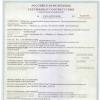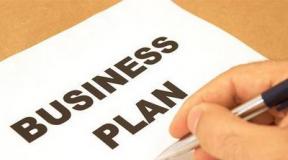How to write a methodological development methodological development on the topic. Registration of methodological aids Name of methodological development
In order for the educational process to be structured and fully provided with all the necessary materials, teachers and teachers prepare various specific documents. In this article, I would like to talk about how to write a methodological development, what it is and why you need to do it at all.
Terminology
Initially, you need to understand what exactly will be discussed now. The first question that may arise for everyone is: "What is methodological development?" So, allowance. It describes various methods and elements that may be useful for conducting a lesson or extracurricular activity. Important points:
- It is possible to prepare a methodological development in relation to only one lesson, topic, or the entire course.
- This document can be both individual and prepared by a whole team of specialists, that is, be collective.
The main goal of methodological development is the pedagogical and professional improvement of the teacher in the preparation of lessons or courses.

Important Points
- The total volume of the document (the so-called "clean text") must be at least 16 sheets of information typed on a computer. And that's not counting the title page and bibliography.
- You also need to remember that the margins should be: 3 cm - on the left, 2 cm each - above, below and on the right.
- The page number is centered at the bottom. The character itself must be Arabic (that is, "1", "2", "3", etc.).
- The font must be Times New Roman, size 14, single. If there are tables in the work, the font of the text written in them is Times New Roman, 12th.
- Text alignment should be according to the width of the page.
- The red line is indented by five characters.
- All headings are in bold type (Times New Roman, size 14), preferably placed in the center of the page.
At the same time, it is important to remember that all illustrations should be designated by the term "Figure" or "Figure", they are all numbered in order. The main part can be divided into sections, subsections.

The main rules for creating methodological development
It is worth saying that methodological development is simpler than it seems at first glance. After all, it is not at all difficult to make it if a person is freely oriented in the material. After all, in this document it only needs to be correctly structured and presented in a form that is easy to read and use. When creating a methodological development, you must adhere to the following important rules:
- The content of the work must clearly correspond to the purpose, as well as necessarily the subject.
- The essence of the creation of methodological development is the submission of information about the most rational and effective organization of the educational process in a particular discipline.
- All developed methods should be creative work, and not copying parts of textbooks, manuals and other pre-existing educational documents.
- The language in the text should be concise, simple and understandable. However, it is also important to use appropriate professional terminology.
- All methods, techniques and forms of presentation of educational material should be "illustrated" with references to their previously applied pedagogical experience.
- In this document, it is necessary to describe all the aids used by the teacher during the presentation of the material to the students. These can be cards, diagrams, tables, instructions for laboratory work, etc.
Looking through the options on how to write a methodological development, it is worth remembering the main thing: everything written must be true. So, it is not necessary to describe this or that method of training if there is no possibility of its logistical support. And most importantly, methodological development should answer the questions: “How to teach? How to make sure that the student learns the material offered by the teacher in the best possible way?

Briefly about the structure
When considering recommendations for writing and designing methodological developments, one must also remember that the presentation of the material must be structured. So, it is very important to remember that any serious work should consist of the following elements (and methodological development is no exception):
- Title page.
- Annotation.
- Content.
- Introductory part, or introduction.
- The main part, where all the material will be presented.
- Conclusion (possible with conclusions).
- List of literature used in the work.
- If necessary, they can be present in the application.

Title page
Now it’s worth figuring out how to properly format all of the above parts of the methodological development. So, the document begins with a title page. It is formatted as follows:
- The name of the institution where this document is submitted is written at the top (the name is indicated in accordance with the issued license).
- The title of the work itself is written in the center of the sheet.
- A little lower from the title, on the right side, you must specify the following information about the author: place of work, position held, and full name.
- In the center at the very bottom, you must indicate the city and year, that is, where and when this methodological development was created.
It is important to note that there are no strict requirements for the design of the title of the work. So, here you can experiment with various design features (however, within the limits of what is permitted, because methodological development is an official document).

annotation
We look further at recommendations for the design of methodological development. At this stage, it is important to talk about what an abstract is and how it should be properly formatted. Indeed, often people are afraid of this word and get lost if you need to make an annotation. So, this is just a brief explanation of what will be outlined later in the document. Here it is important to remember what you need to specify in this case:
- The main thing is to talk about the problem or feature that the developed methodology is devoted to.
- It is necessary to highlight those questions that can be answered in the text below.
- Potential users of this development are also indicated.
The abstract itself should not be large. 10 sentences will be enough, where you need to state the whole point.
Introduction
We go further, understanding how to write a methodological development. After that comes the table of contents, and it will not be difficult to write it. Next on the list is the introduction. This is a very important section of the entire work, where it is also necessary to briefly and easily talk about what is the peculiarity of this work.
- Initially, the novelty of this work, its uniqueness and necessarily relevance are presented. Here you need to tell what the author was guided by when choosing this topic, what makes it special.
- The next step is to describe the purpose of the work.
- The next most important point is the conditions for the application of this work, that is, it is necessary to tell when and in what cases the recommendations set out in the document can be applied.
- You can also indicate the possible difficulties, risks.
The volume of the introduction should not exceed 2 pages of text typed on a computer.
Main part
We continue to talk about how to write a methodological development of a section of the OOP (that is, the main educational program) or just an independent work (regardless of other educational documents). So, it's time to understand how to draw up the main part of the work. It is here that the presentation of all the material that the teacher prepared takes place.
- It is important to reveal the specifics of methodological development.
- It is also necessary to adhere to existing requirements, taking into account the specifics of the discipline.
- It is important to present the material logically so that the author's intention is as clear as possible.

Conclusion
This is the last main part of the work. It is here that certain conclusions are made, and recommendations can also be made. In this section, it is important to talk about where and how everything stated in this methodological development will be put into action. The volume of this text is up to one page.
Everything else not mentioned
The list of references is drawn up in alphabetical order, all normative documents are submitted first. Here you can also specify links to Internet sources (at the very end of the list).
If there are applications in the work, they are submitted after the list of references. Each individual application is numbered with an Arabic numeral, it is given a name (“Appendix 1”, “Appendix 2”, etc.).
Most often, you will also need to write a review of the methodological development. So, they are of two types:
- Internal.
- External.
In the first case, the review is written by an employee of the same institution where the teacher works, in the second case, by a specialist from another educational institution, but always in accordance with the profile and specifics of the methodological development itself.
Memo "How to write a methodological development."
Methodological development is a manual that reveals the forms, means, methods of teaching, elements of modern pedagogical technologies or the technologies of teaching and education themselves in relation to a specific topic of the lesson, the topic of the curriculum, teaching the course as a whole.
Methodological development can be both individual and collective work. It is aimed at the professional and pedagogical improvement of the teacher.
There are quite serious requirements for methodological development.
1. Theme.
2. Full name teacher
3. Purpose of development
4. Abstract. The abstract (3-4 sentences) briefly indicates what problem the methodological development is devoted to, what questions it reveals, to whom it may be useful.
6. Introduction. The introduction (3-4 sentences) reveals the relevance of this work, i.e. the author answers the question why he chose this topic and what is its place in the content of education.
7. The main part is the summary of the lesson itself.
- Group, type of lesson, educational area, goal, tasks by educational areas or integration of educational areas, preliminary work, material, necessary for the lesson.
- the structure (scenario) of the lesson, indicating the sequence of its stages and the approximate distribution of time over these stages;
- methods and techniques of work of the educator at each stage of the lesson; it is necessary to reflect the goals and objectives of the activities of the educator and children, methods and methods for achieving the goals set, the main subject content of the relevant stages, the organization of work at each of the stages;
- the content of the educational material (fragments of the teacher's speech or the full text of the new material);
- tasks for children at each stage, algorithms for completing tasks.
- methodological advice for the period of the next aftereffect (how to sum up, what to do to consolidate the result, etc.).
8. Conclusion. In conclusion (3-4 sentences), the results are summarized on those problematic issues that were raised by the teacher, starting to draw up a methodological development.
9. List of used sources.
10. Applications (specific materials that a teacher can use in his work: task cards, diagram cards, visual, didactic material)
11. The volume of the main content is at least half of the entire manuscript.
On the topic: methodological developments, presentations and notes
Methodical development. Stand - greeting "Droplets" with your own hands. Explanatory note Methodical development. Stand - greeting "Droplets" with your own hands. Explanatory note
Methodical development. Stand - greeting "Droplets" with your own hands. Explanatory note The stand is designed as a greeting of the group (visiting card of the group) called "Droplets". Image from...
Methodical development Didactic game "Feed the kolobok" Methodological development Didactic game "Feed the kolobok" Methodological development Didactic game "Feed the kolobok"
Developed by: Salamatina Irina Borisovna, educator of GBDOU No. 48 of the Kirov region with peas or beans). PetersburgDescription of the game: Purpose: development of fine motor skills, tactile sensitivity ...
This electronic manual is intended for teachers of preschool institutions and parents of preschool children. The purpose of this guide is...
Outline of directly educational activities with preschoolers in the (older age group) Topic: "Magic droplet" Integration of educational areas: "Cognition", "Communication", "...
Methodological development (for senior preschool age)
Toolkit- a complex type of methodological products, which includes a systematized material that reveals the essence, distinctive features and methods of any educational course or direction. Includes extensive didactic material.
The structure of the methodological manual.
1. Title page:
- name of the institution;
- last name, first name, patronymic of the developer;
- title of the grant;
- city name;
- year of development;
2. Abstract:
It is located on the 2nd sheet from the top.
- the essence of the issues under consideration (what is it devoted to);
- purpose (to whom and what kind of assistance it provides);
- source of practical experience;
- possible areas of application;
- information about the author (at the bottom 2 sheets Last name, first name, patronymic, position, place of work, qualification category).
Explanatory note.
Rationale for the relevance of the development. For whom it is intended and in what direction education is used. Justification of the features and novelty of the proposed work in comparison with other developments. Purpose and objectives of methodological development. Scope, a brief description of the expected result.
Content (arbitrary).
In the main part of the manual, depending on the purpose and goals, there may be various chapters. Their title, number, sequence, is determined and logically built depending on the author's intention.
For instance:
1. The theoretical material under study is presented.
2. The main techniques, technologies used or recommended for a successful solution are described.
3. List and description of practical work with recommendations for their implementation.
4. Control tasks for checking and mastering the material.
5. List of literature to help the teacher and student.
6. Applications:
- scheme;
- samples;
- videos;
- creative projects of children;
- thematic photo album.
What is methodological development and the requirements for it.
What is methodological development and requirements,
presented to her.
Methodological development is a manual that reveals the forms, means, methods of teaching, elements of modern pedagogical technologies or the technologies of teaching and education themselves in relation to a specific topic of the lesson, the topic of the curriculum, teaching the course as a whole.
Methodological development can be both individual and collective work. It is aimed at the professional and pedagogical improvement of a teacher or a master of industrial training or the quality of training in educational specialties.
Methodological development can be:
· Development of a specific lesson;
· Development of a series of lessons;
· Development of the theme of the program:
· Development of a general methodology for teaching subjects;
· Development of new forms, methods or means of training and education;
· Methodological developments related to changes in the material and technical conditions of teaching the subject.
There are quite serious requirements for methodological development. Therefore, before you start writing it, you must:
1. Carefully approach the choice of development topic. The topic should be relevant, known to the teacher, the teacher should have some experience on this topic.
2. Determine the purpose of methodological development.
3. Carefully study the literature, teaching aids, positive experience on the chosen topic.
4. Make a plan and determine the structure of methodological development.
5. Determine the direction of future work.
Getting started on the compilation of methodological development, it is necessary to clearly define its purpose. For example, the goal may be as follows: determining the forms and methods of studying the content of the topic; disclosure of the experience of conducting lessons on the study of a particular topic of the curriculum; description of the activities of the teacher and students; description of the methodology for using modern technical and information teaching aids; implementation of the connection between theory and practice in the classroom; the use of modern pedagogical technologies or their elements in the classroom, etc.
Requirements for methodological development:
4. The material should be systematized, presented as simply and clearly as possible.
5. The language of methodological development should be clear, concise, competent, and convincing. The terminology used should be consistent with the pedagogical thesaurus.
7. Methodological development should take into account the specific material and technical conditions for the implementation of the educational process.
8. Orient the organization of the educational process in the direction of the widespread use of active forms and teaching methods.
9. Methodical development should reveal the question "How to teach".
10. Should contain specific materials that a teacher can use in their work (task cards, UPD samples, lesson plans, instructions for laboratory work, diagram cards, tests, level-by-level tasks, etc.).
The structure of methodological development
General structure:
1. Abstract.
3. Introduction.
4. The main part.
5. Conclusion.
6. List of used sources.
7. Applications.
The annotation (3-4 sentences) briefly indicates what problem the methodological development is devoted to, what questions it reveals, to whom it may be useful.
The introduction (1-2 pages) reveals the relevance of this work, i.e. the author answers the question why he chose this topic and what is its place in the content of education.
Methodical development of the theme of the program
The main part may consist of the following sections:
Characteristics of the topic;
· Planning the study of the topic;
The description of the topic indicates:
· Educational goals and objectives of the topic;
· Planning the topic and the number of hours allocated for its study;
· Knowledge and skills that students need to acquire or improve;
· Communication with the previous or subsequent material, as well as intra-subject and inter-subject communications;
· A didactic analysis of the content of the material is given;
· The levels of study and assimilation of educational material are distinguished;
· It is possible to compare the quality of teaching according to the proposed methodology with the methodology that was used by the teacher before using the one proposed in the methodological development.
When planning a learning topic,:
1. Think over the methodology of teaching the topic.
3. Highlight the main questions that students should firmly master.
4. Analyze the educational possibilities of the educational material and the methodology used.
Any of us studies or studied at the university, and has a colossal store of knowledge, but on the question of what a teaching aid is, every second one is “blown away”. No, of course, we all understand that we are talking about a textbook, reference book, literature that helps to learn; but what exactly it is, only a few know. Well, let's try to figure it out together.
What is a teaching aid and its features
So, teaching aid is an official printed publication, the content of which is fully consistent with the curriculum for a particular specialty at the university.
Speaking in simple and accessible language, then this is the most common manual, which from course to course is transferred to students for temporary use.
This is a small reference book, a hint or even a synopsis, which most often touches on only one topic, but in detail.
According to the manuals, they not only perform practical and laboratory work in the classroom, but also correctly draw up reports, in accordance with all the requirements of the Ministry of Education.
So we can safely say that the teaching aid is an indispensable assistant in lectures and practical classes at the university.
Since I'm so enthusiastic about this printed edition, it's time to talk about its significant advantages, against the background of the rest of the literature that is available in the public domain in every student library or reading room.
Advantages of the teaching aid
1. This edition offers a brief thesis information on a given topic, which is much easier to digest and remember.
2. A manual is a kind of instruction or cheat sheet on how to complete tasks in practice, and what aspects of your work you must pay attention to.
3. The manual helps with the design and presentation of the work, and, as you know, an additional point is also added to the final grade for this.
4. The number of pages of the manual does not exceed 30 - 50, which means that carrying such a book in a backpack or bag is not at all difficult.
5. If you wish and have the skills, you can use the manual on the exam as a real hint on the topic. When you don’t have your own cheat sheets, and there is a draft in your head, this is an ideal solution, so it’s better not to forget the training manual for a responsible exam.
However, this teaching aid has its own significant shortcomings, which you also need to know about in advance so as not to be left with a nose:
1. Manuals are in high demand among students, therefore, sometimes it is simply not possible to knock out an extra copy in the library for a subscription. You have to ask your neighbor on the desk, or copy on a copier at your own expense, of course.
2. Manuals have invisible "legs". Yes, yes, this is the printed edition that can disappear in the middle of a couple in an unknown direction and never return.
Again, increased demand affects, so it's best to keep your eyes open, and your own training manual in sight, otherwise problems with a strict librarian in the future simply cannot be avoided.
3.Manuals have a subjective opinion on a particular topic, and this is explained simply - they are created under the editorship of one of the teachers of the department.
Personal hostility and eternal competition of teachers, and your answer according to the training manual is not just erroneous, but “a real mockery” of science (I remember it myself).
But in general, you should not pay attention to such trifles, because the educational and methodological manual, whatever one may say, brings enlightenment to the masses, and this is a tremendous advantage for narrow-minded students.
So stock up on manuals and fight for new knowledge. The main thing is that from your absent-mindedness, the guard does not run away.
Loss of manual
I don’t want to scare anyone, but I simply must warn that the loss of a training manual is not just a nuisance, it is a tragedy of a universal scale for librarians.
First, they begin to sigh and groan from the confession they heard, then they pass this information on from shift to shift, then they come up with a punishment for the absent-minded student, and finally, they remember his last name and put it on a pencil.
Believe me, at the moment when you lost the teaching aid, you made enemies in the face of the entire library staff, including the cleaner. There are two ways out of the situation:
1. Photocopy the same manual and provide it to the library;
2. Buy a new book to the library according to your forced desire.
After that, the conflict is settled, but the librarian will tease you for a long time every time you visit the library and, moreover, pick up a book.
Where do the manuals come from?
The question, of course, is stupid, but in this topic it is very relevant. So who issues these instructions?
The answer is obvious: open the first page and read the name of the author. As a rule, the authors are teachers of their own department, who recommend the purchase of a specific manual. Well, our teachers will never die of modesty, but they scribbled the manuals in order.
The funny thing is that each author praises only his own creation, and does not advise paying attention to the training manuals of his conditional competitors. But, like it or not, but we all studied according to manuals and continue to do this in today's students.
Here we have come to the second main issue, which is on the agenda and is of particular concern to many graduate students and teachers who have not yet dealt with writing such printed publications.
How to write and compose a manual?
In order not to write anything superfluous, let's go straight to the topic, and we will also write out the process of writing the training manual according to the plan, for greater convenience, so to speak.
1. It is necessary to decide on the topic that the planned print edition will be devoted to. You can start with easy information, but in subsequent manuals, touch on more global scientific issues.
2. It is advisable not to study information on the topic from the Internet, which many consider to be a “garbage pit”. It’s not worth the risk, because on the network you can take an unreliable source as a basis, and by great chance. It is better to pay attention to trusted authors, real books and actually primary sources, which abound in the library.
3. So that the learned theory does not seem meaningless, you need to mentally translate it into your practical knowledge in order to eventually have a clear idea of what you will write about in the future.
4. It is advisable to start your work with a preliminary plan, which may consist of short sentences or capacious abstracts. This is very important, otherwise you may miss some important information about the topic being studied.
5. The manual is a cheat sheet, so it must answer in detail the list of main questions. That is why it is advisable to think over their content in advance, and not lose sight of any of them.
6. The content of the manual should not be complicated, and all the material presented should be described in a concise, but simple and easy to read language so that the student does not lose interest and does not abandon it after a boring reading of the first paragraph.
7. All literature used must be certified after the content, and its design also complies with certain rules and regulations that are important to follow.
8. Study all the rules for the design of work and proceed to the further writing of your first teaching aid.
9. Check the finished work using the services of a proofreader (unless, of course, you are a philologist).
10. Submit for verification, and then for publication.
If you decide to write your own educational and methodological manual, then you must definitely remember the elementary rules that will raise the rating of your work, and will not leave it for many years to gather dust on a shelf in the library unnecessarily.
Rule One. It is very important to study the curriculum so that the manual is relevant to the topic, and does not turn out to be useless or irrelevant.
Rule Two. The structure should not only correspond to one topic and not wag, but also contain up-to-date information, the latest information and new discoveries, knowledge. In general, a teaching aid should not fall into the category of "obsolete literature".
Rule Three. The material selected for writing must be structured, accessible, logical, regular and understandable for students. It is advisable to use short phrases and small paragraphs, numbered and bulleted lists, abstracts, various graphic highlights, and, if necessary, tables and graphs.
Rule Four. The list of references should be concise and detailed, and compiled in accordance with the requirements.
Rule Five. Complicated terminology is not welcome, and if its participation is indispensable, then it is desirable to explain in detail the meaning of a particular word, phrase, expression.
Otherwise, your study guide is unlikely to assist a good half of the students in their studies.
Conclusion: Do you need a manual? Choose the most shabby - it is clearly popular and in demand among the masses! You have decided to write your own teaching aid, then express your thoughts simply, clearly, concisely.
Only then will students definitely take note of such a fascinating publication.
Now you know about what is a teaching aid.



















